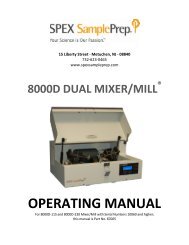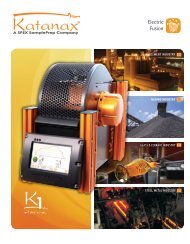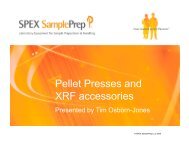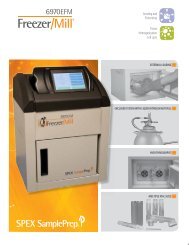8530 Shatterbox Manual 100713 abridged - SPEX SamplePrep
8530 Shatterbox Manual 100713 abridged - SPEX SamplePrep
8530 Shatterbox Manual 100713 abridged - SPEX SamplePrep
Create successful ePaper yourself
Turn your PDF publications into a flip-book with our unique Google optimized e-Paper software.
<strong>8530</strong> <strong>Shatterbox</strong>5.1.4 Emptying and Cleaning the Grinding Container (Cont’d)A cleaned grinding container, which will not be used for some time, should be stored in a plasticbag. Hardened steel grinding containers should always be dried and stored carefully, as theyare prone to surface rusting.5.1.5 Grinding HintsIt is risky to give exact formulas for sample grinding because there are so many variables. Fewtypes of sample have the same grinding characteristics. Grinding containers are made ofdifferent materials, all of which grind differently; furthermore, a worn grinding container will beless efficient than a new one. While there are many analytical techniques that require finelyground samples, the necessary particle size for proper analytical results may vary frominstrument to instrument and from sample to sample. Consequently these guidelines aregeneral.For any grinding container, the smaller the overall sample size, the finer it can be ground in agiven time. Unless a sample cakes during grinding, the longer it is ground, the finer it will get.Particle size can almost always be lowered further by reducing the sample size or lengtheningthe grinding time, or both.Dry grinding is relatively efficient for most brittle materials, but at small particle sizes (below 50microns) there is a tendency for particles to stick back together, or "cake." There are manygrinding aids to prevent caking. Water, alcohol, solvents, and other liquids can be added tocreate slurries whose mean particle size after grinding can be well below 10 microns, but formost analytical techniques the liquid must be removed before analysis. Dry grinding aidsinclude soap powders, detergents, stearates, and aspirin, all added to comprise 1% to 10% ofthe total sample weight. <strong>SPEX</strong> recommends a technique pioneered by Howard Kanare ofConstruction Technology Laboratory: ethylene glycol or propylene glycol is added to thesample in the amount of one drop for every five to ten grams of sample.In most analytical work it is important to reproduce particle size from sample to sample. Likeother laboratory mills, the <strong>Shatterbox</strong> requires a fixed routine to accomplish this: a uniformsample weight, grinding aid, grinding time, container, etc. You are welcome to telephone <strong>SPEX</strong><strong>SamplePrep</strong> LLC at 1-800 522-7739 or 732-549-7144 to discuss your particular application..Page 16 of 28 <strong>SPEX</strong> <strong>SamplePrep</strong> LLC January 2010











